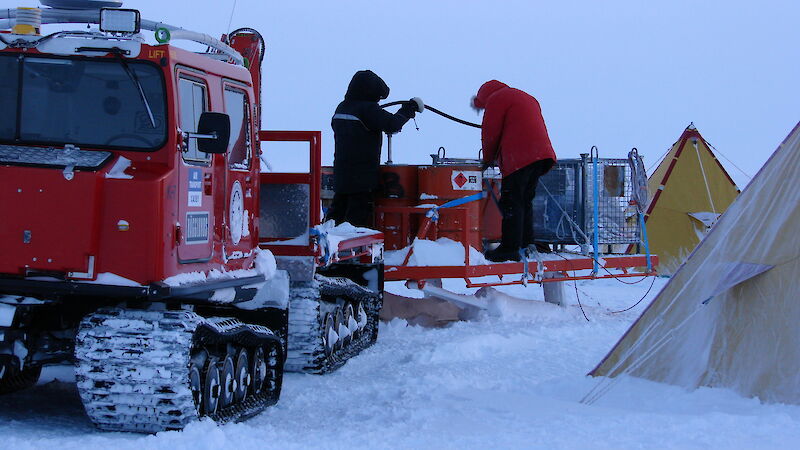Antarctic stations and logistics rely on the use of fuel.
Diesel fuel is used to make water, generate power for light and heating, run vehicles, aircraft and camp stoves. Although we are implementing renewable energy options, particularly at Mawson with the wind turbines and hydrogen demonstration project, we still rely heavily on fossil fuels.
Fuel transfer is always a potentially hazardous procedure, whether it be a major station refuelling operation, or refilling a quad out in the field.
The AAD has developed Fuel Transfer Standard Operating Procedures for all station and field refuelling operations. Observe all the protocols when refuelling your vehicles either on station or out in the field. Always use a spill tray when refuelling a stove out in the field.
To minimise the potential for fuel spills, observe the following rules:
- Always refuel vehicles on return to station
- If refuelling in the field take a field fuel spill kit and be familiar with its operation
- Only refuel in still conditions to minimise the likelihood of spills
- If fuel is spilt, use the fuel spill kit to contain the spill and if possible return contaminated snow/soil for treatment on station
- Report all spills to the Station Environment Officer
If a fuel spill occurs
If you have a fuel spill, report it immediately to your station leader and clean it up as best you can with the fuel spill kit.
You must also log it as soon as possible in the Incident, Hazard and Improvement Suggestion (IHIS) reporting system accessible from the AAD intranet.
If the spill occurs on station, we have hydrocarbon soil sampling kits at each station for use to determine the extent of the spill and to carry out soil samples.
Fuel spill kits
Fuel spill kits for use in refuelling quads in the field have been designed and tested in the field by AAD staff.
These include fuel spill containment and recovery equipment for initial responses to fuel spills in field camps and at stations. Fuel spill equipment has been updated at each station to reflect changing operational practices.
The spill trays can also be used as fuel bunds under standing generators while they are running or being refuelled, and under stoves and jiffy drills during refuelling.
The kits include the AAD designed spill tray to minimise risk of spills onto soil, rock or ice during refuelling, as well as removable absorbent pads for mopping up should a spill occur. The trays are collapsible for easy transport, have self supporting side walls, and have been designed with tie-down points and tent pegs to keep them in place.
They can also double up as storage bunds for 20 litre containers in the field.
The fuel spill kits include:
- a spill tray (a large one for quads and a smaller one for fuel stoves)
- absorbent mat and pillows
- protective gloves
- plastic bags with ties for the storage of oily waste
- drum top covers
- mini spill boom
Hydrocarbon soil sampling kit
Soil analysis may required to determine an appropriate response to a spill using a hydrocarbon soil sampling kit. This kit is packaged for field use at a single sampling event. It contains chemically cleaned glass vials and a 1000 ml glass container, clean metal teaspoons and Nitrile disposable gloves. It also includes a 30 m tape measure, steel tent pegs and hammer to mark out the sample site, notebook, pencil and permanent felt marker pen. Comprehensive instructions with storage and shipping permits forms are also provided.
In the event of a hydrocarbon spill, the chain of events after the spill would be as follows:
- Immediate response and containment as per instructions in the Fuel Transfer Standard Operating Procedures
- Report the incident — using radio contact between site and station leader, through incident reporting on the Incident, Hazard & Improvement reporting system on the AAD Intranet, or by email or phone contact with the Operations Safety & Environment Officer (OSEA) or bioremediation scientists (AAD EPiC Programme)
- Take advice from OSEA and bioremediation scientists on whether sampling is appropriate and any further incident specific sampling instructions.
- If soil sampling is required:
- collect initial samples using the kit provided on station.
- return samples to the bioremediation scientists in Australia
- undertake follow-up action as advised by OSEA and bioremediation scientists

